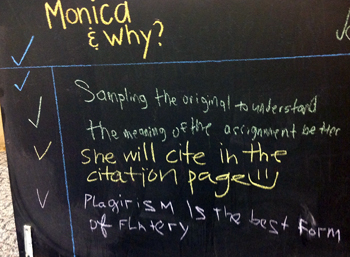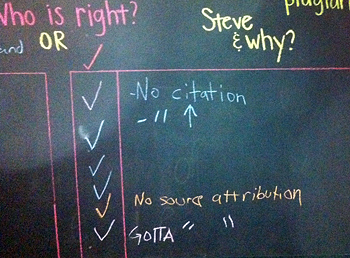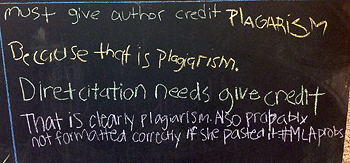During the month of October designated as National Information Literacy Awareness Month UC Libraries invites students to think about scenarios that have to do with the way we use information and decide what is the right thing to do. Earlier this month we posted the following prompt:

Thanks to everyone who contributed their opinions. Several students thought Monica was right.

A couple of students indicated that whatever it took to a pass a class was OK, especially if it was a BoK class, which, unfortunately, is not a unique attitude. “We all copy dude,” said someone. We hope this is not the case!
In response to the student who paraphrased C. C. Colton’s quote “Imitation is the sincerest flattery,” it is worth noting that some education systems support teaching writing by imitation. This is definitely not an approach used at UC and in American educational institutions, where imitation is usually regarded as a form of plagiarism. Plagiarism, a severe academic offense, has nothing to do with flattery! By the way, did you know that the work “plagiarism” goes back to Latin plagiarius “kidnapper, seducer, plunderer, one who kidnaps the child or slave of another?” (Online Etymology Dictionary)
 The majority correctly thought that Steve was right, because Monica did not cite the source or provide attribution or, more specifically, she did not put quotation marks around the borrowed passage. Steve’s supporters said that the author needs to be credited. They described Monica’s action as plagiarism. This understanding is correct. The UC Code of Conduct provides a very detailed definition of plagiarism, which includes, but is not limited to, submitting as your own someone else’s work or material borrowed from anywhere in any form.
The majority correctly thought that Steve was right, because Monica did not cite the source or provide attribution or, more specifically, she did not put quotation marks around the borrowed passage. Steve’s supporters said that the author needs to be credited. They described Monica’s action as plagiarism. This understanding is correct. The UC Code of Conduct provides a very detailed definition of plagiarism, which includes, but is not limited to, submitting as your own someone else’s work or material borrowed from anywhere in any form.
Someone said that in order to judge who was right one would know the outcome and another student disagreed with this. Indeed, even if Monica were to get away with stealing a source with attribution, this would still be a case of “intellectual kidnapping” and Monica is simply cheating herself out of proper education by not making an effort to write her paper and cite her sources properly. Faculty are familiar with student “voices” by reading various contributions and hearing them talk in class, so they will suspect plagiarism when they see a difference in the tone of the paper, unusual use of language, or other indicators of borrowed text.
Someone noted that they thought “borrowing” from a source implied citation  and quotes – great comment! In a paper or report you acknowledge the use of sources through in-text parenthetic notes, footnotes, or end-notes. In addition, you provide a bibliography of sources at the end of your paper. Just citing the borrowed fragment in the bibliography is not enough! In addition, both your in-text references and bibliography should follow a certain citation format, for example. MLA or APA. So the student who noted that Monica probably did not format the source properly had a very good point!
and quotes – great comment! In a paper or report you acknowledge the use of sources through in-text parenthetic notes, footnotes, or end-notes. In addition, you provide a bibliography of sources at the end of your paper. Just citing the borrowed fragment in the bibliography is not enough! In addition, both your in-text references and bibliography should follow a certain citation format, for example. MLA or APA. So the student who noted that Monica probably did not format the source properly had a very good point!
Citing sources properly is not easy, but librarians are always here to help you sharpen your information literacy skills! You can get help from librarians whenever you need it. In addition, we have a number of CampusGuides to help you with citing your sources and use information ethically and legally.
By Olga Hart
